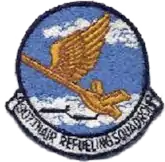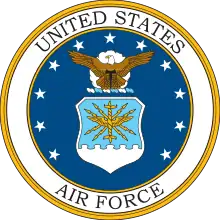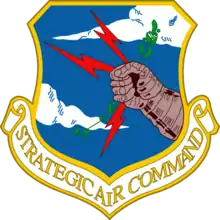907th Air Refueling Squadron
The 907th Air Refueling Squadron is an inactive United States Air Force unit. It was last assigned to the 91st Bombardment Wing at Glasgow AFB, Montana, where it was inactivated on 25 June 1968. From 1963 to 1968 the squadron served as the air refueling element of its parent wing.
| 907th Air Refueling Squadron | |
|---|---|
 Boeing KC-135 Stratotanker taking off using water injection to increase thrust | |
| Active | 1942–1945; 1963–1968 |
| Country | |
| Branch | |
| Role | Air Refueling |
| Nickname(s) | Hump T Dumps (CBI Theater) |
| Engagements | China Burma India Theater |
| Insignia | |
| Patch showing 907th Air Refueling Squadron Emblem |  |
| 27th Troop Carrier Squadron Emblem (approved 25 February 1943)[1] |  |
The first predecessor of the squadron was the 27th Troop Carrier Squadron, a World War II troop carrier squadron that served in the China Burma India Theater as an airlift unit. Its last assignment was with the 443d Troop Carrier Group at Liangshan, China, where it was inactivated on 27 December 1945.
The two squadrons were consolidated into a single unit in 1985, but the consolidated unit has not been active since.
History
World War II
The 27th Transport Squadron was activated in early 1942[1] as one of the original five squadrons of the 89th Transport Group.[2] The squadron acted as a replacement training unit[3] under I Troop Carrier Command, initially training transport and glider pilots, then replacement aircrews.[1] The unit used militarized versions of the Douglas DC-3 (C-48s and C-49s) at first, then it flew Douglas C-47 Skytrains and Douglas C-53 Skytroopers.[2] From June to August 1942 the squadron moved to Kellogg Field, Michigan, where it was attached to the 62d Troop Carrier Group. In July 1942 the squadron and its parent group were redesignated as Troop Carrier units. In November 1943 the replacement training mission terminated and the 27th prepared for transfer overseas to the China Burma India Theater.[1]

The air echelon of the squadron gathered at Baer Field, Indiana, where it received new aircraft. It ferried the airplanes to India via the South Atlantic ferry route, leaving Morrison Field, Florida in December and arriving in India in January. The ground echelon did not arrive in theater until late March[4]
The squadron flew airlift missions and evacuated wounded personnel, sometimes landing on unimproved airstrips. It participated in Operation Thursday, the transport of troops behind enemy lines in Burma, along with aircraft of the 1st Air Commando Group. After moving to China, the squadron supported Office of Strategic Services missions in China and Southeast Asia.[4] The squadron remained in China after the termination of hostilities in August 1945 and was inactivated there in December.[1]
Cold War
The 907th Air Refueling Squadron was established in July 1963 by Strategic Air Command at Glasgow Air Force Base, however its first Boeing KC-135 Stratotanker did not arrive until October and it was December before the squadron became combat ready.[5][6] The squadron mission was to provide air refueling support to the Boeing B-52 Stratofortress strategic bombers of its parent 91st Bombardment Wing and other USAF units as directed, including supporting Operation Chrome Dome airborne alert sorties.[7] The squadron kept half its aircraft on fifteen-minute alert, fully fueled and ready for combat to reduce vulnerability to a Soviet missile strike[8] until it became nonoperational in 1968, except for periods when it deployed its aircraft and aircrews to support operations in the Pacific.
The 907th deployed to the Western Pacific region to support Operation Arc Light from September 1966 to March 1967 and to Okinawa from February to March 1968 during the Pueblo Crisis.[9] It also deployed to Southeast Asia to support Operation Young Tiger, refueling tactical aircraft on strike missions.[10]
The squadron became non-operational in May 1968[9] and was inactivated in June when Glasgow closed.
The 27th Troop Carrier Squadron and the 907th Air Refueling Squadron were consolidated in 1985,[11] but the consolidated unit has not been active.
Lineage
|
27th Troop Carrier Squadron
|
907th Air Refueling Squadron
|
Assignments
- 89th Transport Group, February 1942
- 10th Transport Group (later Troop Carrier Group), 15 June 1942 (attached to 62d Transport Group (later Troop Carrier Group), 21 June 1942 – 5 August 1942)
- Tenth Air Force, 12 January 1944 (attached to Troop Carrier Command, Eastern Air Command)
- 443d Troop Carrier Group, 6 March 1944 – 27 December 1945 (attached to 69th Composite Wing, 21 May 1944 – c. July 1945)[12]
- 91st Bombardment Wing, 1 July 1963 – 25 June 1968 (detached ca. 11 September 1966 – c. 31 March 1967 and c. 5 February 1968 – c. 16 March 1968, not operational after c. 1 May 1968)[9]
Stations
|
|
Aircraft
|
|
Campaigns
| Campaign/Service Streamer | Campaign | Dates | Notes |
|---|---|---|---|
| American Theater | 1 February 1942 – 13 December 1943 | 27th Transport Squadron (later Troop Carrier Squadron)[1] | |
| India-Burma | 12 January 1944 – 28 January 1945 | 27th Troop Carrier Squadron[1] | |
| China Defensive | 12 January 1944 – 4 May 1945 | 27th Troop Carrier Squadron[1] | |
| China Offensive | 5 May 1945 – 2 September 1945 | 27th Troop Carrier Squadron[1] |
References
Notes
- Maurer, Combat Squadrons, pp. 140–141
- Maurer, Combat Units, pp. 154–155
- Replacement Training Units were oversized units that trained individual pilots or aircrews Craven, & Cate, (eds.) Vol. VI, p. xxxvi
- 14 USAAF 27 Troop Carrier Squadron website (retrieved 14 October 2013)
- Abstract, History 91 Bombardment Wing Sep 1963 (retrieved 14 October 2013)
- Abstract, History 91 Bombardment Wing Dec 1963 (retrieved 14 October 2013)
- Abstract, History 91 Bombardment Wing Oct–Dec 1965 (retrieved 14 October 2013)
- "Abstract (Unclassified), History of the Strategic Bomber since 1945 (Top Secret, downgraded to Secret)". Air Force History Index. 1 April 1975. Retrieved 4 March 2014.
- Ravenstein, pp. 125–127
- Abstract, 91 Bombardment Wing Fact and Figures Booklet, Jan and Feb 1966 (retrieved 14 October 2013)
- Department of the Air Force/MPM Letter 662q, 19 September 85, Subject: Reconstitution, Redesignation, and Consolidation of Selected Air Force Tactical Squadrons
- Lineage, including assignments and stations through 1945 in Maurer, Combat Sqyuadrons, pp. 140–141
Bibliography
![]() This article incorporates public domain material from the Air Force Historical Research Agency website http://www.afhra.af.mil/.
This article incorporates public domain material from the Air Force Historical Research Agency website http://www.afhra.af.mil/.
- Craven, Wesley F; Cate, James L, eds. (1955). "Introduction". The Army Air Forces in World War II. Vol. VI, Men & Planes. Chicago, Illinois: University of Chicago Press. p. xxxvi. LCCN 48003657.
- Maurer, Maurer, ed. (1983) [1961]. Air Force Combat Units of World War II (PDF) (reprint ed.). Washington, DC: Office of Air Force History. ISBN 0-912799-02-1. LCCN 61060979.
- Maurer, Maurer, ed. (1982) [1969]. Combat Squadrons of the Air Force, World War II (PDF) (reprint ed.). Washington, DC: Office of Air Force History. ISBN 0-405-12194-6. LCCN 70605402. OCLC 72556.
- Ravenstein, Charles A. (1984). Air Force Combat Wings, Lineage & Honors Histories 1947–1977. Washington, DC: Office of Air Force History. ISBN 0-912799-12-9.
Further reading
- Smith, Richard K. (1998). Seventy-Five Years of Inflight Refueling: Highlights, 1923–1998 (PDF). Air Force History and Museums Program. Washington, DC: Government Printing Office. Retrieved 13 August 2013.
External links
- 14 USAAF 27 Troop Carrier Squadron website (retrieved 14 October 2013)


.png.webp)